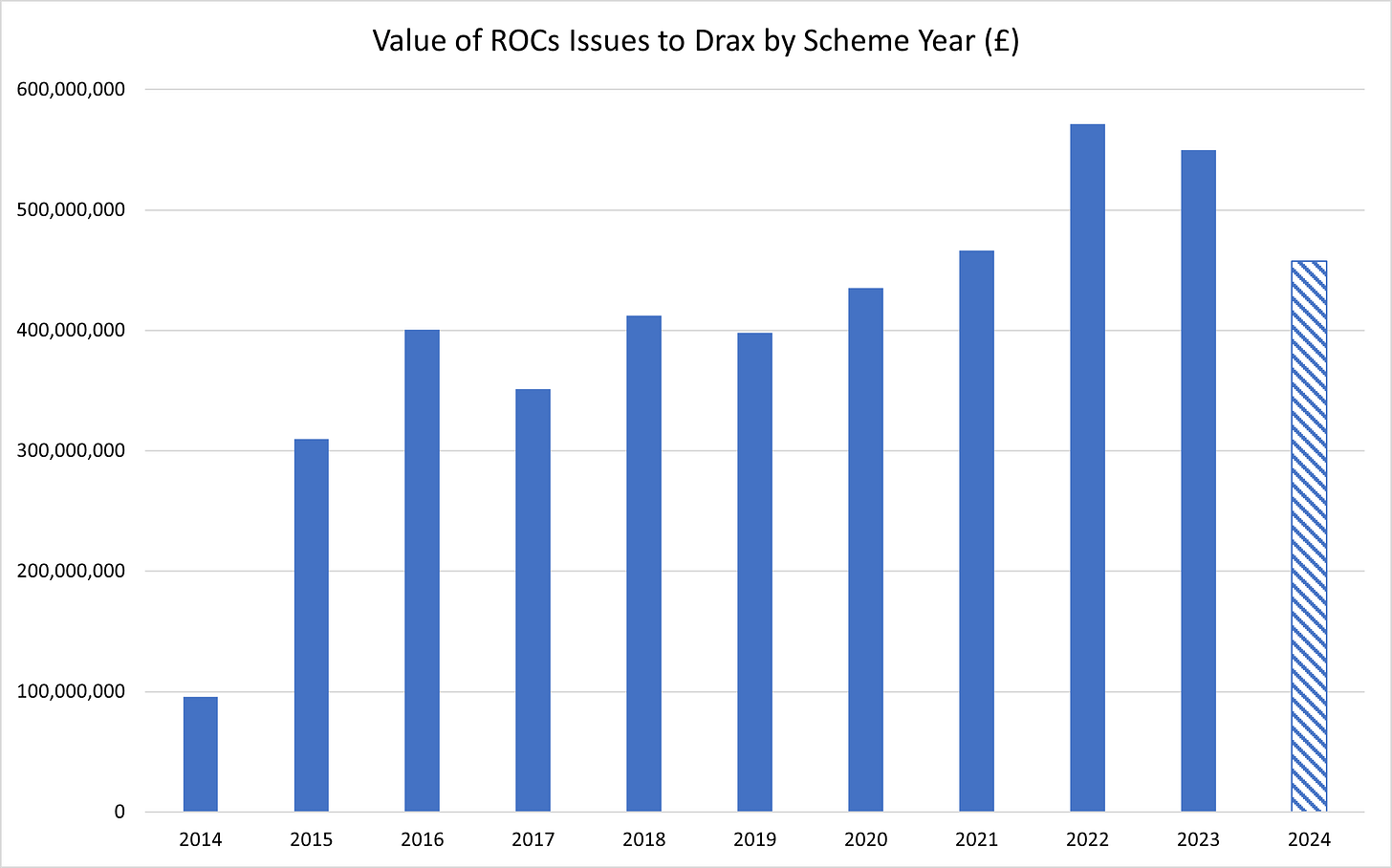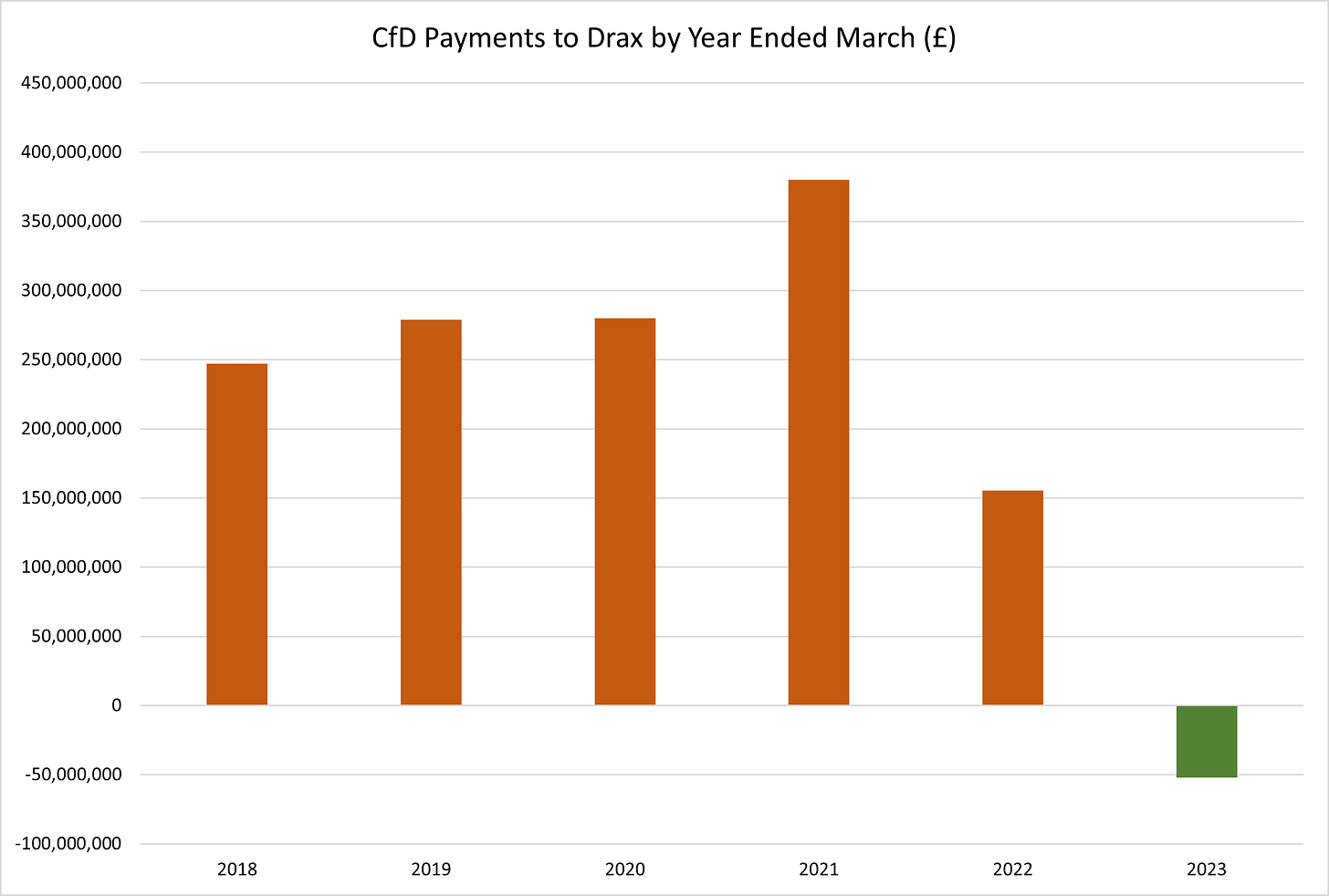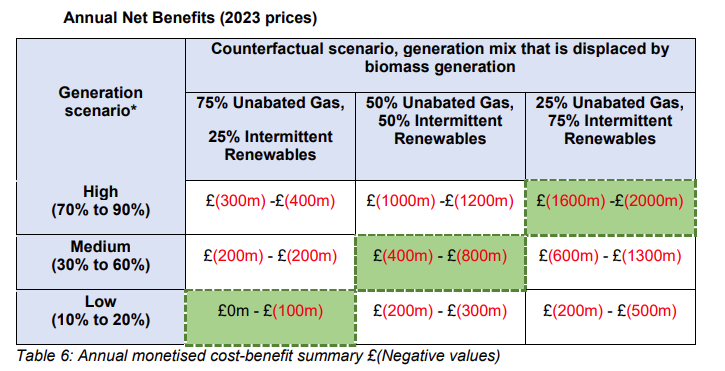Drax: The Tale of Dosh and BECCS
An in depth looks at the support for tree-burning at Drax.
Introduction
Last month, the Government opened a consultation on providing transitional support for biomass plants to bridge the gap from when the current subsidy regime ends in 2027 to 2030 when biomass with carbon capture and storage (BECCS) is expected to come online.
This article takes an in depth look at biomass and Drax in particular and the new arrangements proposed by the Government for BECCS.
What is Bioenergy and BECCS
Bioenergy can cover a wide range of technologies. However, in the UK it mostly means burning trees at Drax power station near Selby in North Yorkshire. This is where trees are chopped down in North America, pulped into pellets, dried (which takes a lot of energy), shipped across the Atlantic (more energy) and then burned at Drax to produce electricity. Currently, this is classed as carbon neutral even though burning wood produces more CO2 per MWh generated than burning coal and it will take decades for the trees to regrow.
Adding carbon capture and storage (CCS) to this means that the emissions from burning the trees are captured and allows the operator to claim that BECCS is a negative emissions technology or a net carbon sink.
There are several significant problems with this technology. The first is emissions. Campaigners Biofuelwatch reported in 2017 that particulate emissions from Drax were 897 tonnes in 2016, up from 382 tonnes in 2008 when it was burning coal. So much for renewables being clean and saving the planet.
Second, biomass is not very energy dense and a lot of the embedded energy in the wood is wasted in the pulping, drying and transportation processes that get it to Drax power station. This means that biomass on its own has an extremely low energy return on energy invested (EROEI). However, the position gets even worse when power plants are converted to BECCS because it takes even more energy to capture the CO2 and pump it underground for long term storage. The Royal Society of Chemistry produced a report that suggested BECCS using willow pellets from Louisiana in America would have an EROI of less than one. This means we get less useful energy out than it takes to run the overall process (see Figure 1).
In short, standalone biomass is a poor energy source and BECCS is a net energy sink. In other words, a thermodynamic war crime that only the most ignorant and muddle-headed bureaucrat would consider for more than a nanosecond.
Drax Subsidy Regimes
However, the Government is determined that biomass will form a significant part of its plans to decarbonise the electricity grid and has lavished massive subsidies on Drax for many years. Drax operates under two subsidy regimes. Part of the plant is funded using renewable obligation certificates (ROCs) and part using Contracts for Difference (CfDs).
Drax ROC Scheme
The ROC scheme has been very generous to Drax as shown in Figure 2 (data from Ofgem portal).
Drax has been issued ROCs with a total value of £4.45bn from April 2013 to October 2023. Over £500m was received in years ended March 2022 and 2023. In the seven months of fiscal year ended March 2024 for which data has been reported, Drax has been issued £457m of ROC certificates.
Drax CfD Scheme
The CfD scheme has been running for less time and overall is not quite as generous as the ROC scheme. From December 2016 to mid-January 2024, Drax has received £1.38bn of CfD payments. Figure 3 shows the payments by financial year ended in March, for each full year of operation (data sourced from the Low Carbon Contract Company).
CfD payments rose steadily from year-ended March 2018 to March 2021, where they peaked at £380m. They fell in 2022 and in year ended March 2023, Drax actually repaid money as it received more for the power it generated than the CfD strike price. The CfD guarantees Drax £132/MWh in the current fiscal year, which is more expensive than onshore wind, solar PV and some offshore wind farms. This gives a total subsidy of ~£5bn since April 2013, just to burn trees.
It is also interesting to combine the ROC and CfD data and plot the subsidies by month as shown in Figure 4.
ROC generation fluctuates up and down but is typically about 800GWh per month. CfD generation has a different pattern. Throughout 2020 and the first half of 2021, generation was fairly constant around 400GWh per month. Then in late 2021, CfD generation fell to zero in September and October, then rose again to March 2022 and then fell again and produced little from October 2022 to September 2023. We can get a clue why this might be from Figure 5 which zooms in on just daily CfD generation from the beginning of January 2022 to mid-January 2024.

In late March 2022, the Reference Price (essentially the price Drax is expected to achieve in the market for its power) rose above the CfD strike price and generation fell off a cliff shortly thereafter. Generation then continued in fits and starts to the end of September 2022 when the reference price rose sharply to over £400/MWh. At that point, CfD generation produced virtually nothing for an entire year, the only exception being two large spikes in December 2022 and July 2023 and a small spike in May 2023. Once the reference price dropped below the strike price again in late September 2023, it started generating again.
When the strike price is below the reference price, Drax gets paid a top up to the strike price for the power it produces. When the reference price is above the strike price, it has to pay back the difference, although it should still receive the strike price for its power. It remains a mystery why it should all but cease CfD generation for almost a year. The timing of generation stopping and restarting coincides almost exactly with the changes in the reference price, so it does not seem likely that it is due to maintenance.
Consultation on Transitional Subsidies for Biomass
The Government is committed to transition from coal to biomass to power BECCS. They also believe that it is unlikely that power BECCS could become operational before 2030. The current support arrangements for biomass generation are due to end in 2027. As a result, the Government is consulting on whether to provide transitional support for biomass generators to cover the gap between 2027 and 2030.
The consultation acknowledges that biomass generation is “typically subject to relatively high fuel prices.” The Government is concerned that if support is removed, then biomass power plants would not be able to compete in the market so would be retired and associated fuel supply chains would be lost. We are in big trouble if even dispatchable renewables like biomass cannot compete in the market without subsidy. This destroys the claim that renewables are cheap.
They have produced an impact assessment of the costs and benefits to be borne by consumers of providing support. Figure 6 shows the results of their calculations.
Depending upon how much biomass power is generated, the annual costs to the consumer vary from £0-£100m (low generation) to £1,600-£2,000m (high generation). Given that the current plan is to retire the remaining coal-fired plants by October 2024 and some of our nuclear power plants are due to close in 2026 and 2028, it is fairly certain that the biomass plants will be running at a level commensurate with the high generation scenario.
The costs highlighted above are net of the “social value” benefits of not emitting CO2 from unabated gas-fired generators, so the actual tangible costs are in the range of £2-£2.5bn per year. This figure is for the whole of the biomass sector, not just Drax. But Drax is by far the largest biomass generator.
New proposals for BECCS
This transitional funding is just a stop gap before even more lavish subsidies are devised to support BECCS, which as a reminder is bioenergy with carbon capture and storage (CCS). The Government views BECCS as a key technology to support its vision for engineered Greenhouse Gas Removal (GGR).
The important thing to remember about CCUS is that it reduces the efficiency of gas-fired power plants by 14-20%. It will probably have a similar effect on biomass plants. The implication of this is that a plant with CCUS will require 16-25% more fuel to produce the same amount of electrical output. In effect, CCUS is an energy tax on thermal generation, so it is not surprising that these plants will require extra subsidy. The Government has set out some broad principles governing the strike price of the subsidies available but has not yet set the level. In fact, BECCS will qualify for two subsidies. The first is a Contract for Difference for electricity (CfDe) and the second is a Contract for Difference for carbon (CfDc). It is no surprise that such a thermodynamic disaster will require lavish subsidies.
The Government has not yet made a formal decision on the level of subsidy they will allow this project, but they have granted planning permission for the Drax BECCS project. This technology is very immature and there is no guarantee of success. CCS projects across the world have been beset with problems. For instance, the Gorgon project in Western Australia has consistently failed to achieve its target of capturing 80% of the CO2 in the project’s gas stream. Two Norwegian projects have also proved very challenging for the operator Equinor and had to be halted for a time last year because of high costs.
Free-market think tank the IEA has published a paper that is critical of BECCS. Even Ember, a think tank that usually advocates for renewables technology, has described BECCS as “an expensive gamble” and could cost £1.7bn per year in subsidies. Moreover, the Energy and Climate Intelligent Unit (ECIU) has said BECCS could “do more harm than good”. Even the BBC has started publishing articles that are critical of Drax, because they have found that Drax is burning pellets from ecologically important “old-growth” forests. When the green think tanks and the BBC are critical of Drax, the Government should take notice.
Conclusions
Electricity generation from standalone biomass is already extremely expensive and inefficient. Adding CCS to make BECCS makes the technology a net energy sink which of course is even more expensive. The Government should drop any plans it may have for BECCS.
In an ideal world, we would also stop such large-scale biomass generation too. However, our coal-fired plants are schedule for closure later this year and most of the remaining nuclear capacity will reach the end of its life and close over the next few years. Our gas-fired generation fleet is aging, leading to the risk of blackouts. This will mean that the biomass units at Drax will be essential to keeping the lights on during dark, calm winter evenings when there is no solar power and precious little wind generation. I fear the Government will have no choice but to keep these plants running, spending billions of our cash. However, they should also entertain the heretical notion of keeping the remaining coal-fired plants running and, heaven forbid, consider converting Drax back to burning coal.
If you have enjoyed this article, please share it with your family, friends and colleagues and sign up to receive more content







This literally makes my brain hurt. Drax 'carbon neutral' biomass is the result of our supposed leaders' brains running in neutral for extended periods. Energy policy in this country is the equivalent of an engine running, making lots of noise, where the Fat Controller has his foot on the accelerator, pressing it down harder and harder, but we get nowhere at all. The lights are on, blinking furiously, but Net Zero neurons are making any meaningful connections in the brains of those charged with formulating and implementing our national energy policy. It's not going to remain that way. Sooner or later, some bright spark is going to shove the engine into reverse and watch gleefully as Britain crashes its way back through centuries of industrial progress to the Dark Ages.
Even devout environmentalists now question the credentials of this form of renewable generation and want it removed from being classified renewable. Reality is in the short term (and thats if you believe they will plant replacement trees and manage them) its doing far more damage than keeping burning coal. The problem though is there is nothing to replace a big slug of dispatchable generation and the govt will say its from a diversifiable fuel source but enough people in the US are challenging whats going in Louisiana you could easily see it stopped. Furthermore with the shambles over nuclear we need every Watt we can lay our hands on for next 5 years + so govt needs to find a fudge. Labour wont change it and likely to double down as they still say we can decarbonise the grid by 2030 (they can't nor could they with 28B/yr) so can't afford to lose DRAX's so called renewable contribution. The whole thing is a mess but in the list of messes plenty of things trump net zero currently in the eyes of the electorate so nothing will change.
Oh and by the way existing ROC payments increase by 9.7% in April and CfD by 3.9% so Drax will be gaining even more subsidy. Interestingly they don't get any CM payments for biomass maybe excluded due to ROC payment regime.